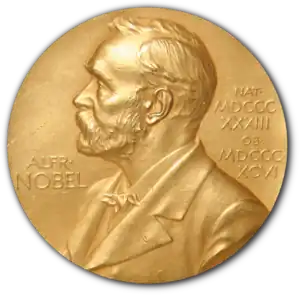John Howard Northrop | |
|---|---|
 | |
| Born | July 5, 1891 Yonkers, New York, U.S. |
| Died | May 27, 1987 (aged 95) Wickenburg, Arizona, U.S. |
| Alma mater | Columbia University |
| Known for | Studies of enzymes |
| Awards | Nobel Prize in Chemistry (1946) Daniel Giraud Elliot Medal (1939) |
| Scientific career | |
| Fields | Biochemistry |
| Institutions | University of California, Berkeley Columbia University Rockefeller University |
John Howard Northrop (July 5, 1891 – May 27, 1987) was an American biochemist who, with James Batcheller Sumner and Wendell Meredith Stanley, won the 1946 Nobel Prize in Chemistry. The award was given for these scientists' isolation, crystallization, and study of enzymes, proteins, and viruses.[1] Northrop was a Professor of Bacteriology and Medical Physics, Emeritus, at University of California, Berkeley.[2]
Biography
Early years
Northrop was born in Yonkers, New York to John Isaiah, a zoologist and instructor at Columbia University who is a member of the Havemeyer family, and Alice Rich Northrop, a teacher of botany at Hunter College. His father died in a lab explosion two weeks before John H. Northrop was born. The son was educated at Yonkers High School and Columbia University, where he earned his BA in 1912 and PhD in chemistry in 1915.[3][4] During World War I, he conducted research for the U.S. Chemical Warfare Service on the production of acetone and ethanol through fermentation. This work led to studying enzymes.
Research
In 1929, Northrop isolated and crystallized the gastric enzyme pepsin[5] and determined that it was a protein. For this achievement, he was elected to the United States National Academy of Sciences in 1934.[6] In 1938 he isolated and crystallized the first bacteriophage (a small virus that attacks bacteria), and determined that it was a nucleoprotein. He was elected to the American Philosophical Society that same year.[7] Northrop also isolated and crystallized pepsinogen (the precursor to pepsin), trypsin, chymotrypsin, and carboxypeptidase.
For his 1939 book, Crystalline Enzymes: The Chemistry of Pepsin, Trypsin, and Bacteriophage, Northrop was awarded the Daniel Giraud Elliot Medal from the National Academy of Sciences.[8] He was elected a Fellow of the American Academy of Arts and Sciences in 1949.[9] Northrop was employed by the Rockefeller Institute for Medical Research in New York City from 1916 until his retirement in 1961. In 1949 he joined the University of California, Berkeley as Professor of Bacteriology, and later, he was appointed Professor of Biophysics.[10]
Personal life
In 1917, Northrop married Louise Walker (1891–1975), with whom he had two children: John, an oceanographer, and Alice, who married Nobel laureate Frederick C. Robbins. The family lived in a small home just outside of Mt. Vernon, New York. As their children grew older and Northrop looked for a more desirable workplace, the family bought a home in Cotuit, Massachusetts. This move shortened Northrop's commute to the laboratory in Princeton, New Jersey, and also put him in closer contact with the wilderness which he greatly enjoyed.[11] Northrop committed suicide in Wickenburg, Arizona in 1987.[12]
References
- ↑ "The Nobel Prize in Chemistry 1946 – Preparing Pure Proteins". Retrieved December 14, 2008.
- ↑ "University of California: In Memoriam, 1988".
- ↑ "Alexander Hamilton Medal". Columbia College Alumni Association. December 14, 2016. Retrieved June 24, 2022.
- ↑ Columbia College (Columbia University). Office of Alumni Affairs and Development; Columbia College (Columbia University) (1960–1961). Columbia College today. Columbia University Libraries. New York, N.Y. : Columbia College, Office of Alumni Affairs and Development.
- ↑ Northrop, J. H. (1929), "Crystalline Pepsin", Science, 69 (1796): 580, Bibcode:1929Sci....69..580N, doi:10.1126/science.69.1796.580, PMID 17758437
- ↑ "John H. Northrop". www.nasonline.org. Retrieved May 19, 2023.
- ↑ "APS Member History". search.amphilsoc.org. Retrieved May 19, 2023.
- ↑ "Daniel Giraud Elliot Medal". National Academy of Sciences. Archived from the original on December 29, 2010. Retrieved February 16, 2011.
- ↑ "Book of Members, 1780–2010: Chapter N" (PDF). American Academy of Arts and Sciences. Retrieved April 15, 2011.
- ↑ "John H. Northrop – Biographical". Nobel Foundation. Retrieved April 29, 2017.
- ↑ Biographical Memoirs. 1994. doi:10.17226/4560. ISBN 978-0-309-04976-4.
- ↑ See p. 440 of Herriott, R. M. (1994), "John Howard Northrop: July 5, 1891 – May 27, 1987", Biographical Memoirs. National Academy of Sciences (U.S.), vol. 63, pp. 423–450, PMID 11615389
Further reading
- Economos, A. C.; Lints, F. A. (1985), "Growth rate and life span in Drosophila V. The effect of prolongation of the period of growth on the total duration of life (J.H. Northrop, 1917) – revisited", Mech. Ageing Dev. (published December 1985), vol. 33, no. 1, pp. 103–113, doi:10.1016/0047-6374(85)90112-5, PMID 3908838, S2CID 23576391
- Herriott, R. M. (1981), "John Howard Northrop", J. Gen. Physiol. (published June 1981), vol. 77, no. 6, pp. 597–599, doi:10.1085/jgp.77.6.597, PMC 2215443, PMID 7021760
- Herriott, R. M. (1994), "John Howard Northrop: July 5, 1891 – May 27, 1987", Biographical Memoirs. National Academy of Sciences (U.S.), vol. 63, pp. 423–450, PMID 11615389
- See also this version of Northrop's National Academy of Science biography.
- Northrop, J. H. (1939), Crystalline Enzymes, Columbia University Press
- Shampo, M A; Kyle, R. A. (2000), "John Northrop – definitive study of enzymes", Mayo Clin. Proc. (published March 2000), vol. 75, no. 3, p. 254, doi:10.4065/75.3.254, PMID 10725951
- van Helvoort, T. (1992), "The controversy between John H. Northrop and Max Delbrück on the formation of bacteriophage: bacterial synthesis or autonomous multiplication?", Annals of Science (published November 1992), vol. 49, no. 6, pp. 545–575, doi:10.1080/00033799200200451, PMID 11616207
External links
- Works by or about John Howard Northrop at Internet Archive
- John Howard Northrop on Nobelprize.org including the Nobel Lecture on December 12, 1946 The Preparation of Pure Enzymes and Virus Proteins
